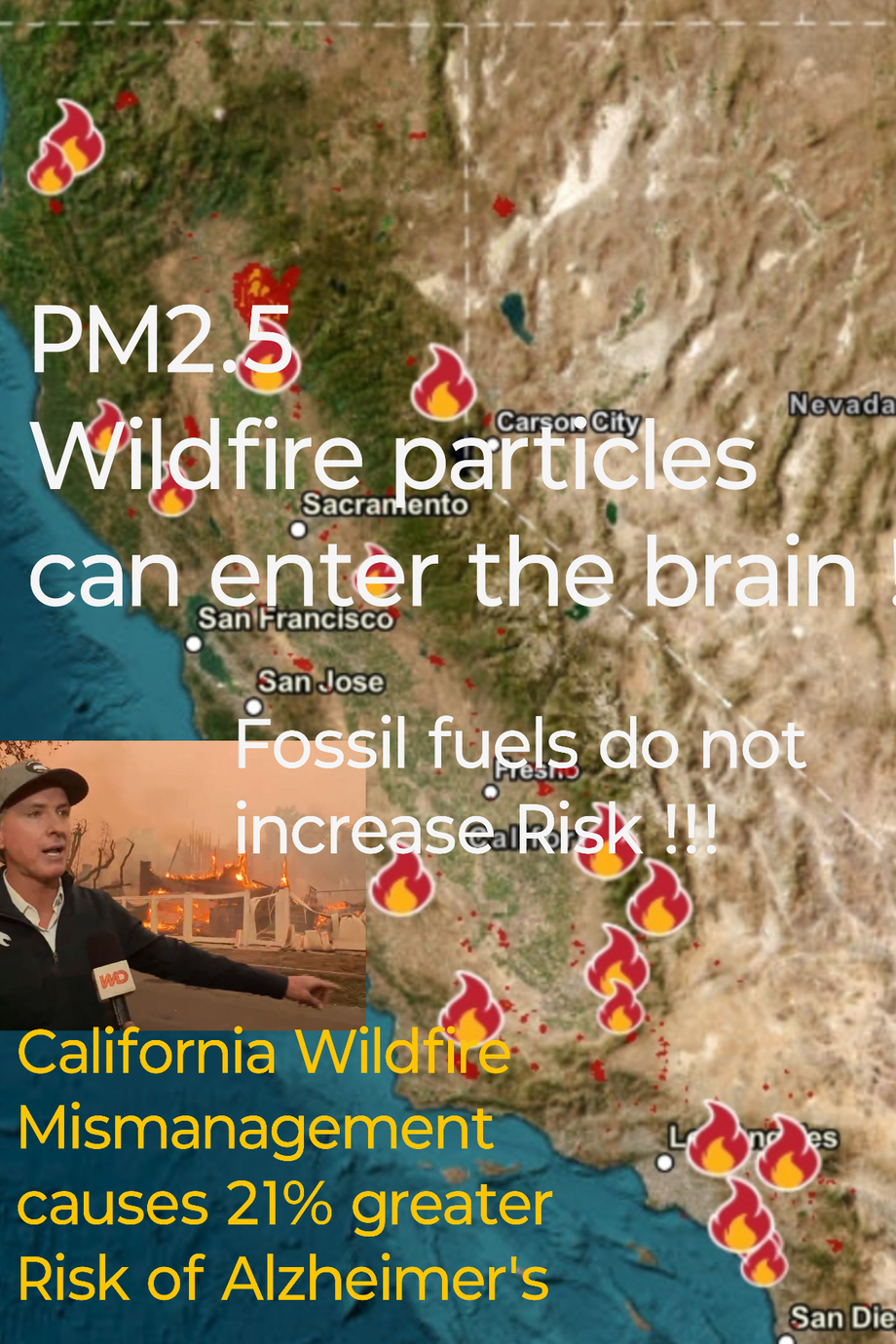Mismanagement causes Alzheimer's
(Click...)
151,000 Californian's Alzheimer's
was caused by smoke from mismanaged
Wildfires.
Governor Newsom has been in California
Politics for 30 years...
An NIH-funded research team, led by Dr. Joan Casey of the University of Washington School of Public Health, compared the links between exposure to PM2.5 from wildfires or other sources and new cases of dementia. To do so, they looked at electronic health records of more than 1.2 million Kaiser Permanente Southern California members aged 60 or older who were initially free from dementia. The health data spanned the years 2008-2019. The researchers estimated total PM2.5 concentrations by census tract (a small, defined area) from 2006 to 2019 using air quality and weather data. They also used data on wildfires to separate wildfire PM2.5 from other sources of PM2.5. Results appeared in JAMA Neurology on Nov. 25, 2024.
More than 80,000 people in the study received a dementia diagnosis. The team looked at how dementia diagnoses varied with average PM2.5 concentrations over the previous three years. They found that for every 1 μg/m3 increase in average wildfire PM2.5, the odds of receiving a dementia diagnosis increased by 18%. In contrast, a 1 μg/m3 increase in average PM2.5 from other sources was associated with only a 1% increase in the odds of a dementia diagnosis.
The researchers next looked at how these associations varied with age, sex, race/ethnicity, and neighborhood poverty. The association between wildfire PM2.5 and dementia incidence was stronger among people who were less than 75 years old at baseline compared to those who were 75 and older. People who lived in poorer areas also showed a stronger association between wildfire PM2.5 and dementia. And the association was stronger among certain minority groups, such as Asian and non-Hispanic Black people.
.From: Chuck Darling
July 30, 2025
Wildfire Smoke is different from
Fossil fuel smoke.
The pm2.5 particles are different from
Fossil Fuel Particles.
They enter the bloodstream, and the brain,
causing inflammation,
and a 21% greater risk of Alzheimer's.
California Wildfire Mismanagement
puts Californians, and neighboring states
at a 21% greater risk of
Alzheimer's disease, and other
organic damage.
California has a significant number of Alzheimer's cases, with an estimated 720,000 people aged 65 and older living with the disease.
The estimated per patient cost of formal care was $28,078
That's $20,216,160,000 dollars...
Another 151,200 Alzheimer's cases
bringing the total to 871200 cases,
costing $24,461,553,600 dollars...
An extra cost of $4,245,393,600 dollars, $4.2 Billion !
BEFORE INFLATION, and assuming
that they are not HOSPITALIZED !
Right, Governor ?
I think the extra toxicity of wildfire smoke is due to COPPER NANOPARTICLES.
- cd 7/30/25
Nope.
- CD August 11, 2025
The molecular formula for chlorophyll is C55H72MgN4O5, according to Sigma-Aldrich and other sources. This formula represents chlorophyll a, the most common type of chlorophyll.
Here's a breakdown of the formula:
C55: 55 carbon atoms
H72: 72 hydrogen atoms
Mg: 1 magnesium atom
N4: 4 nitrogen atoms
O5: 5 oxygen atoms
The chemical formula for chlorophyll b is C55H70MgN4O6. Chlorophyll b is an accessory pigment found in plants, algae, and some bacteria, working alongside chlorophyll a to capture light energy during photosynthesis.
Pyrolysis of chlorophyll, the process of heating chlorophyll in the absence of oxygen, can lead to the formation of various hydrocarbons, including isoprenoid hydrocarbons and aromatic compounds. The specific products and their relative yields depend on factors like temperature, heating time, and the presence of other materials like clay minerals.
Here's a more detailed breakdown:
Key Observations:
Isoprenoid hydrocarbons:
Chlorophyll pyrolysis can produce isoprenoid hydrocarbons, particularly prist-1-ene (2,6,10,14-tetramethyl-1-pentadecene), a compound often found in kerogen (the organic matter in sedimentary rocks).
Prist-1-ene causes Lupus like symptoms and polyarthritis in
test animals...
Phytadienes:
Phytadienes are also formed during chlorophyll pyrolysis, especially in unheated or briefly heated samples.
Aromatic compounds:
At higher temperatures, aromatic compounds like phenol, benzene, and their derivatives can be formed.
Clay minerals:
The presence of clay minerals can influence the pyrolysis products, potentially promoting the formation of prist-1-ene and other isoprenoids.
Temperature and time:
Higher temperatures and longer heating times generally lead to more extensive decomposition and the formation of a wider range of products.
Examples:
Preheating:
Preheating chlorophyll a at 250°C for varying times can significantly affect the yield of prist-1-ene during subsequent pyrolysis at higher temperatures (e.g., 400°C or 470°C).
Two-stage pyrolysis:
Chlorophyll can be pyrolyzed at 340°C, producing mainly C20-isoprenoid hydrocarbons, and then the residue can be pyrolyzed again at 470°C, yielding isoprenoids with fewer carbons.
Clay-catalyzed pyrolysis:
Chlorophyll pyrolysis in the presence of clay minerals can lead to the formation of a significant amount of material that is insoluble in organic solvents but can be extracted by other solvents, and this extract can produce isoprenoid hydrocarbons upon pyrolysis.
Significance:
Understanding geological processes:
Chlorophyll pyrolysis is relevant to understanding the formation of organic matter in sedimentary rocks and the origin of compounds found in fossil fuels.
Biomass pyrolysis:
Chlorophyll is a component of biomass, and its pyrolysis behavior can be relevant to the study of biomass conversion processes.
Mineral commodities produced from National Forests and Grasslands include gold, silver, copper, platinum, palladium, lead and zinc, sand, gravel, decorative and building stone, along with coal, oil and gas, phosphates and geothermal resources.
Albino coastal redwood (Sequoia sempervirens) sprouts, while lacking chlorophyll and thus unable to photosynthesize, are believed to play a role in heavy metal detoxification for the parent tree. These albino sprouts accumulate high levels of heavy metals like nickel, cadmium, and copper
What happens when the albino sprouts burn..?
studies also link copper dyshomeostasis to AD pathogenesis. Elevated levels of unbound "free" copper have been observed in the serum and brain of AD patients, potentially leading to increased oxidative stress and mitochondrial dysfunction. This excess copper can bind to amyloid-beta (Aβ) peptides, forming a complex that promotes Aβ aggregation and plaque formation, a hallmark of AD. Excessive copper has also been linked to tau protein phosphorylation and the formation of neurofibrillary tangles, another key AD pathology.
[Chuck's 00Cedar JPICedar ]
[ This page built with JPICedar by Chuck Darling Wednesday July-30- 2025 Time : 6:27pm]
https://archive.ph/






